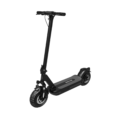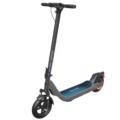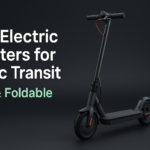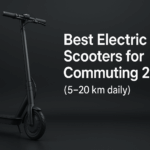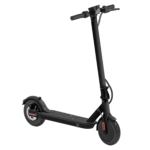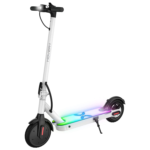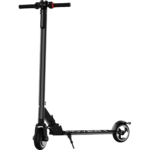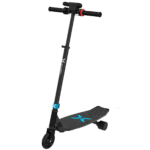- Home
- Scooters
- Electric Scooters
- Hover-1 Highlander
Hover-1 Highlander
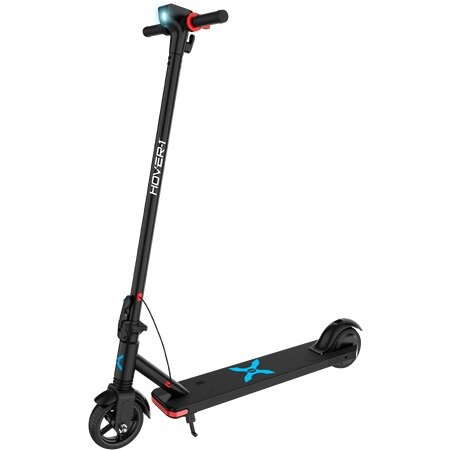

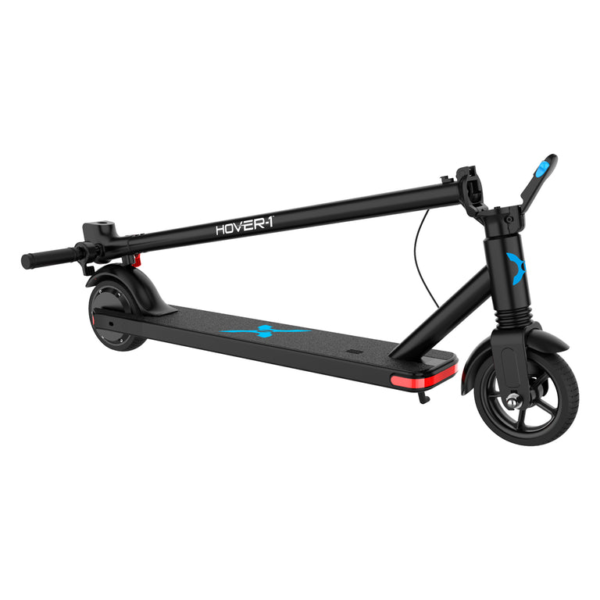
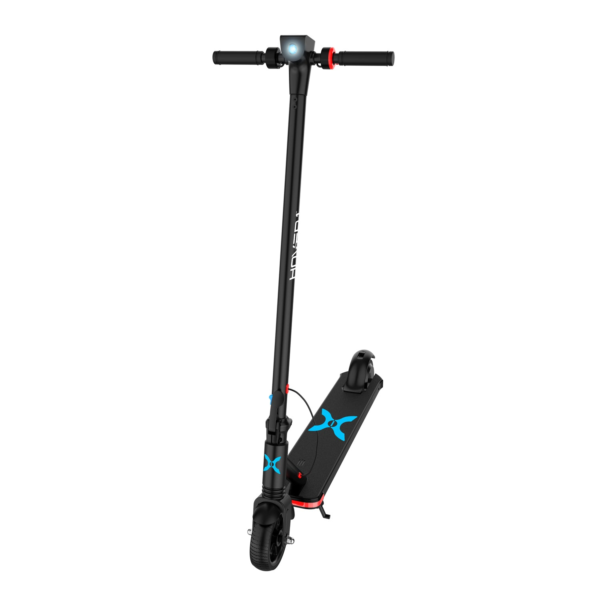
- Battery Range: 9 miles (14 km)
- Top Speed: 15 mph (24 km/h)
- Motor Power: 250 W
- Weight Capacity: 220 lb (100 kg)
- Charging Time: ≈3 h
- Scooter Weight: 33.0 lb (15.0 kg)
PROS
- Affordable 250 W design
- Electronic + foot brake combo
- 6.5″ solid tires (no flats)
- Fast 3-hour charge
- Folds compactly
CONS
- Short 9-mile range
- No suspension
- IP rating not listed
Table of contents
- What Is the Hover-1 Highlander?
- How the Hover-1 Highlander Works
- Key Specifications
- Design & Build Quality
- Performance Fundamentals
- Battery, Range & Efficiency
- Ride Quality & Comfort
- Braking & Safety Features
- Portability & Daily Usability
- Maintenance & Care
- Weather & Seasonal Considerations
- Hover-1 Highlander vs Alternatives
- Who the Hover-1 Highlander Is (and Isn’t) For
- FAQs
- Glossary
- Final Notes on Using the Highlander Well
The Hover-1 Highlander is a compact, beginner-friendly electric scooter built for short urban hops and campus rides. It trades raw power for simplicity, low maintenance, and a folded size that fits tight spaces. If you want an approachable first scooter that keeps daily travel straightforward, the Highlander hits that brief without drama. Moreover, it does so with predictable controls and a clear, focused feature set.
What Is the Hover-1 Highlander?
The Highlander is a lightweight, foldable e-scooter designed around a 250-watt rear hub motor, a 36-volt lithium-ion battery, and 6.5-inch solid tires. It caps speed at up to 15 mph (24 km/h) and lists a rated range up to 9 miles (15 km) under favorable conditions. Because the tires are solid, you avoid flats and routine tube replacements. However, the ride feels firmer on cracks and seams, especially on older pavement.
This model prioritizes practicality. The folding stem and modest footprint help with apartment living, dorm storage, and quick multimodal trips. Additionally, a clear LCD display shows speed, mode, and battery bars so you can gauge charge at a glance. It also includes a built-in headlight and an electronic brake paired with a mechanical foot brake. Consequently, everyday stops feel intuitive even for new riders.
If you weigh near or below the 264 lb (120 kg) limit, travel on mostly smooth pavement, and keep expectations aligned with a 250 W scooter, the Highlander offers a tidy, low-upkeep way to cover short distances. In short, it suits short commutes, campus loops, and neighborhood errands.
How the Hover-1 Highlander Works
Motor & controller. A 250 W brushless motor sits in the rear wheel hub. The electronic controller meters power based on your thumb throttle input and selected mode. The Highlander uses three speed modes—Eco, Normal, and Sport—which cap speed at approximately 7, 11, and 15 mph (11, 18, and 24 km/h) respectively. Think of it like “gearing by software.” Eco trims acceleration and top speed to conserve battery. Sport, by contrast, lets the controller deliver the motor’s full allowed output for its class.
Battery & energy. The battery is a 36 V, 5.0 Ah lithium-ion pack (about 180 Wh of stored energy). Under light loads and warm temperatures, that energy aligns with the scooter’s rated range. As conditions get tougher—colder weather, hills, frequent stops—the controller draws more watts to maintain speed, and the battery empties sooner. Therefore, pacing and environment strongly influence distance.
Throttle & kick-to-start. The thumb throttle requests torque. However, the Highlander will not launch from a full stop; it uses kick-to-start. First you push to about 1.8 mph (3 km/h), then you press the throttle to engage the motor. This safety design reduces accidental takeoffs and eases controller stress. Furthermore, it teaches smooth starts right from day one.
Brakes. The left control activates an electronic brake that retards the hub motor. The rear fender provides a mechanical foot brake for extra stopping force. You can feather the electronic brake for gentle deceleration and add the foot brake when you need a firmer bite. As a result, you get balanced, predictable stopping across varied surfaces.
Lighting & display. The front LED switches on from the cockpit. Meanwhile, the display shows speed, battery bars, and mode icons. Icons also indicate when the light is active, so you can confirm at a glance.
Key Specifications
Values below reflect the official Highlander manual. Imperial and metric units are shown side-by-side for clarity. The table gathers the specifications you need for quick reference, and it groups them by use.
| Block | Item | Value |
|---|---|---|
| General | Model | H1-HLNR |
| Net Weight | 37.41 lb (16.97 kg) | |
| Max Supported Weight | 264 lb (120 kg) | |
| Minimum Rider Weight | 44 lb (20 kg) | |
| Performance & Power | Motor | 250 W brushless rear hub |
| Top Speed | Up to 15 mph (24 km/h) | |
| Speed Modes | Eco ~ 7 mph (11 km/h), Normal ~ 11 mph (18 km/h), Sport ~ 15 mph (24 km/h) | |
| Battery, Charging & Electrical | Battery Voltage / Capacity | 36 V, 5.0 Ah (~180 Wh) |
| Rated Range | Up to 9 miles (15 km) | |
| Charge Time | Up to ~3 hours | |
| Charger Input | AC 100–240 V, 50/60 Hz | |
| Build & Dimensions | Tire Type / Size | 6.5 in (front solid) + 6.5 in (rear solid) |
| Open Size (L × W × H) | 38.54 × 15.9 × 44.2 in (97.9 × 40.4 × 112.3 cm) | |
| Folded Size (L × W × H) | 39.37 × 15.75 × 15.75 in (100 × 40 × 40 cm) | |
| Frame | Aluminum | |
| Safety & Control | Brakes | Electronic (regen) + mechanical foot brake |
| Headlight | Front LED (no factory reflectors) | |
| Kick-to-Start | Yes, ~1.8 mph (3 km/h) | |
| Features & Extras | Display | LCD speedometer, mode, battery |
| Bluetooth Speaker | Built-in | |
| Cruise Control | Not listed | |
| Warranty & Compliance | Compliance | FCC Part 15 |
| FCC / BT IDs | FCC ID: 2AANZHLNR / BT ID: D051448 | |
| Warranty | See purchase documentation; keep proof and serial |
Note: An official IP water-resistance rating is not listed. Accordingly, avoid wet conditions.
Additionally, the table above organizes the specifications into practical blocks, so you can scan what matters before a ride.
Design & Build Quality
The Highlander’s frame uses aluminum for a balance of strength and weight. The stem folds via a lever and a twist collar that locks it in place. The hinge feels simple by design, yet it is easy to operate. Because the unit is compact and uses small wheels, the folded size is cube-like and easy to tuck behind a desk or in a closet.
The cockpit is clean. You get a central LCD with speed, battery bars, and mode indicators. The power button handles on/off and toggles the headlight. The throttle sits on the right; the electronic brake sits on the left. Consequently, the control layout feels familiar within minutes.
On the deck, you’ll find a grippy pad and a modest stance length suitable for most adults. The rear fender doubles as a foot brake. Cable routing stays tidy, and the outer plastics feel utilitarian rather than fancy. Overall, fit-and-finish aligns with the scooter’s mission: keep daily riding uncomplicated while avoiding parts that demand constant tuning.
Because the tires are solid, you won’t chase punctures. On the other hand, the ride is firmer. Since the deck and stem don’t include suspension hardware, you rely on your knees to absorb impacts. On smoother paths the ride feels planted. On broken pavement or expansion joints, you’ll notice sharper feedback and should slow accordingly.
Before you ride, review the specifications and the load limit. That way, you’ll set expectations and protect the hardware.
Performance Fundamentals
Launch and acceleration. With 250 W, launch is gentle. Sport mode quickens response, yet the scooter keeps everything predictable and beginner-friendly. From a rolling start, the controller feeds steady current to the hub, so the scooter climbs to neighborhood speeds without surging. Meanwhile, Eco and Normal modes blunt throttle inputs further, which helps new riders build confidence.
Speed holding. On flat stretches, the Highlander sits near its 15 mph (24 km/h) cap in Sport, provided the battery has charge and the wind stays light. Normal mode is comfortable for crowded paths. Eco mode keeps speed low on campus walkways and shared zones. Therefore, you can tailor pace to the space without fuss.
Stability. The short wheelbase and small diameter wheels make steering quick. At moderate speeds, the deck feels stable with a neutral stance. Because tire contact patches are smaller than on 8.5- or 10-inch scooters, you should ride with smooth inputs, especially over painted lines and slab seams. As a result, you maintain grip and reduce twitchiness.
Hill behavior. Expect light-duty climbs. On ~7–10% grades, the scooter slows but continues to turn the motor if you enter with momentum and keep the throttle steady. On longer hills, shift to Normal or Eco to keep controller temperatures happy. If a climb stalls near walking pace, step off and push for a few yards before trying again. That strategy preserves battery and controller health.
Battery, Range & Efficiency
A 36 V, 5.0 Ah pack equals ~180 watt-hours. The rated up to 9 miles (15 km) assumes easy terrain, a lighter rider, warm temperatures, and modest speeds. Real-world range changes with conditions; therefore, plan conservatively and charge sooner rather than later.
- Rider mass. Heavier riders see more watt draw at any speed. Range shortens accordingly.
- Terrain. Hills and rough surfaces increase consumption. Flat, smooth pavement stretches distance.
- Temperature. Batteries perform best in mild warmth. Cold weather can reduce output and usable capacity.
- Speed & pacing. Holding Sport mode at the top speed drains energy faster. Smooth, steady cruising extends range.
To maximize range and battery life:
- Ride in Normal mode when you can. The top-speed drop is small, but the energy savings add up.
- Build speed gradually. Hard launches draw peak current and warm the controller.
- Keep tires clean and the deck free of debris. Rolling friction matters on small wheels.
- Charge soon after rides. The listed ~3-hour charge time brings you back to full quickly.
- Store at room temperature. Long-term storage works best at about half charge in a dry, cool space.
- Avoid full drains. Frequent 20–80% cycles are kind to lithium-ion packs.
With mindful pacing and favorable weather, light riders may approach the rating on easier routes. Conversely, in tougher conditions you should plan for less and charge accordingly.
Ride Quality & Comfort
Tires & feel. The 6.5-inch solid tires ride firm. On smooth asphalt, they roll efficiently and track straight. On cracked sidewalks and lumpy patches, you’ll feel more vibration than on larger pneumatic tires. Therefore, bend your knees, shift weight over bumps, and scan ahead to avoid sharp edges.
Ergonomics. The deck supports a natural staggered stance. The stem height works for most adults, and the cockpit stays uncluttered. Because the scooter is compact, tighter turns feel easy in courtyards and bike paths. Furthermore, the short wheelbase helps with quick maneuvers.
Noise & vibration. Brushless hub motors run quietly. You will hear a faint whir on acceleration and some resonance over rough surfaces. Keep fasteners snug—especially around the folding joint and brake hardware—to minimize rattles over time. If you notice noise, re-check the hinge and collar before continuing.
Stem flex. The folding mechanism includes a lever and locking twist collar. When it is properly secured, the stem feels solid for this class. Check engagement before every ride. If you ever feel play at the hinge, stop and lock things down before proceeding.
Braking & Safety Features
Electronic brake. The left control engages a motor-based brake that slows the rear hub smoothly. It’s ideal for routine speed control and light stops. Because it’s electronic, it doesn’t depend on pads or cables to create initial drag. Consequently, you get repeatable response every time.
Mechanical foot brake. Press the rear fender for additional stopping power. Use it in tandem with the electronic brake when you need a firm, short stop. Practice modulating both so you can keep the scooter straight under load. In emergencies, apply steady pressure rather than stabbing the brake.
Lighting. The headlight improves forward visibility at dusk. The manual notes the scooter does not include factory reflectors. Therefore, consider reflective clothing and additional stick-on reflectives if you ride near traffic in low light.
Rider limits. Respect the 264 lb (120 kg) load cap and use the speed modes as intended. The manual sets temperature and usage guidelines; follow them to protect electronics and battery longevity. Additionally, always check the folding collar before each ride.
Portability & Daily Usability
Fold & carry. The stem folds down over the deck, and the twist collar locks the hinge. At ~37.41 lb (16.97 kg), the scooter can be carried up a flight of stairs, though it’s best for short hauls. The folded size (100 × 40 × 40 cm) makes it simple to store vertically in a corner or horizontally on a shelf. Furthermore, the compact cube-like footprint fits tight closets.
Parking & storage. Use the kickstand on level surfaces. Indoors, keep the scooter dry and out of direct sunlight. Outdoors, avoid long exposure to heat, rain, or freezing temperatures. Covering electronics and storing the scooter inside will extend its life. As a result, the finish and hardware will age better.
Security habits. If you must leave it unattended, use a sturdy lock through the frame or a dedicated locking point. Record your serial number and keep proof of purchase with your files. Moreover, avoid leaving it overnight outside.
Daily rhythm. Because the battery can recharge in around three hours, you can top off after a morning trip and ride again later the same day. The LCD battery bars give a quick glance at charge level; try to plug in before you drop to the last bar. Consequently, you’ll avoid deep cycles that stress the pack.
Maintenance & Care
Solid-tire scooters cut down on puncture chores, but they still benefit from simple checks. Therefore, build a quick routine.
Pre-ride (30–60 seconds):
- Confirm the folding collar and lever are locked.
- Squeeze the electronic brake and test the rear foot brake gently.
- Check for debris wedged near wheels and under the deck.
- Power on the light if visibility is low.
Weekly (5–10 minutes):
- Inspect fasteners at the stem hinge, handlebar, and fender. Tighten to snug—not overtight.
- Wipe dust from the deck, display, and charging port cover.
- Cycle through Eco/Normal/Sport to confirm mode switching works.
Monthly (10–15 minutes):
- Check for play in the stem. If you feel movement, lock the collar fully and retest.
- Examine the foot brake for wear or bending; adjust your technique if you scuff it heavily.
- Clean the tires with a damp cloth and look for cuts or embedded pebbles.
Battery habits:
- Keep the pack near 20–80% when stored for more than a week.
- Avoid charging in very hot or very cold environments.
- Use only the correct charger model and inspect the cable for damage.
Consistently following these steps reduces squeaks, protects threads, and preserves the battery. In addition, it helps you catch issues early.
Weather & Seasonal Considerations
Rain and puddles. The Highlander does not list an official IP rating. That means you should avoid wet riding. Water ingress can harm the controller, motor, or battery. If you encounter standing water, step off, lift the scooter, and walk around. As a rule, treat moisture as a high-risk scenario for electronics.
Heat. High ambient temperatures increase battery stress. Park in the shade and allow the scooter to cool before charging. Never leave it in a hot car. Otherwise, cells can degrade faster.
Cold. In cold weather, range drops noticeably. Plan shorter trips, ride in lower modes, and store the scooter indoors to keep the battery warm before use. Additionally, start the day with a room-temperature pack for better performance.
Seasonal storage. For breaks longer than a month, clean the scooter, charge the battery to roughly half, and store it in a dry room. Check charge monthly and top up if it falls below two bars. Consequently, you’ll avoid deep discharge during downtime.
Hover-1 Highlander vs Alternatives
Versus “commuter” scooters (8.5–10 in, 300–500 W). The Highlander is easier to store and avoids flats, yet it rides firmer and climbs less strongly. Commuter-class models carry more speed and range, but cost and maintenance typically rise. Thus, choose based on distance and comfort priorities.
Versus “performance” scooters (dual motors, suspension). Performance models deliver headroom on hills and braking, yet they weigh much more and demand space. The Hover-1 Highlander excels when portability and simplicity outweigh speed goals. Nevertheless, enthusiasts may prefer the power of bigger machines.
Versus “off-road” scooters (knobby tires, large decks). Off-road builds thrive on rugged surfaces and wide bars. The Highlander is strictly a paved-path scooter. It shines on smooth bike lanes, campuses, and neighborhood streets. Conversely, it is not meant for dirt or gravel.
When the Highlander excels. Short trips, quick indoor storage, flat-to-moderate terrain, and riders who appreciate no-flat tires. Its strengths are predictable controls, easy folding, and low daily upkeep. Therefore, it’s a solid first e-scooter for many new riders. If you are cross-shopping within the same family, consider the Hover-1 Alpha as another approachable option.
Who the Hover-1 Highlander Is (and Isn’t) For
Ideal for:
- Students who want a compact scooter for campus loops.
- Apartment dwellers with minimal storage.
- First-time riders who value gentle acceleration and simple controls.
- Last-mile commuters pairing rides with bus or rail.
Not the best fit for:
- Long-distance commuters who need 15–20+ miles (24–32+ km) per charge.
- Riders on steep, sustained hills.
- Those who want plush suspension and large pneumatic tires.
Consequently, if you ride short paved routes and value easy storage, the Hover-1 Highlander makes sense. If you routinely climb hills or ride rough roads, consider a larger platform instead.
FAQs
1) What is the real-world range?
Expect less than the up to 9 miles (15 km) rating when conditions are tough. Cold weather, hills, higher speeds, and heavier loads reduce distance. Smooth surfaces and moderate pacing help you get closer to the claim.
2) Can I ride in the rain?
An official IP rating is not listed. To protect electronics and the battery, avoid wet conditions and standing water. If you get caught out, slow down and seek shelter.
3) Does it have cruise control?
Cruise control is not listed for the Highlander. The three speed modes let you choose a comfortable cap without locking the throttle.
4) How does the braking feel?
The electronic brake gives smooth deceleration. Use the mechanical foot brake for stronger stops. Practice modulating both so you can stay straight and stable.
5) What tire pressure should I use?
The Highlander uses solid tires, so there is no pressure to set. Periodically wipe tires clean and inspect for cuts or lodged debris.
6) What does this Hover-1 Highlander overview include?
It covers the official specifications, core features, usability tips, and care guidance to help new riders set accurate expectations.
7) How often should I charge it?
Top off after rides when practical. For storage longer than a week, leave the battery around half charge and keep it in a dry, room-temperature space.
Glossary
- Ah (amp-hours): Battery capacity; higher Ah means more charge stored.
- Wh (watt-hours): Battery energy (V × Ah); a direct indicator of range potential.
- Brushless hub motor: An electric motor built into the wheel hub with low maintenance needs.
- Controller: The electronic module that regulates power from the battery to the motor.
- Regen (electronic brake): Motor-based braking that resists wheel rotation; can recapture a small amount of energy.
- Kick-to-start: Safety feature requiring a push before the throttle engages.
- Speed modes: Software caps for speed and acceleration—Eco, Normal, Sport.
- Stem flex: Perceived movement at the fold or handlebar; check locks before riding.
- IP rating: Ingress Protection score for dust and water; not listed for this model.
- Pneumatic tire: An air-filled tire that cushions bumps; not used here.
- Solid tire: Airless tire that resists punctures but rides firmer.
- Top speed: Maximum assisted speed under ideal conditions.
- Rated range: Distance claimed under favorable conditions; actual range varies.
- Load limit: Maximum rider and cargo weight the scooter supports.
- Kickstand: Deployable prop to keep the scooter upright when parked.
Final Notes on Using the Highlander Well
Keep expectations matched to the platform, and the scooter rewards you with dependable transport. Use Normal mode for everyday paths, save Sport for open stretches, and apply your brakes smoothly and early. Lock the hinge every time you unfold the stem, charge with the correct adapter, and avoid rain. Therefore, your battery, controller, and fittings should last longer with fewer surprises.
Specifications
General
| Model The Model specifies the exact version or name of the scooter. It helps identify its unique design, features, and specifications within the manufacturer’s product line. Knowing the model makes it easier to compare options, find compatible accessories, or look up support information. | Highlander |
| Brand The Brand identifies the manufacturer or company that designs and produces the scooter. A trusted brand is a sign of quality, reliability, and good customer support. Well-known brands often have higher standards for safety, performance, and after-sales service, giving you more confidence in your purchase. | Hover-1 |
| Release Date The Release Date indicates when the scooter model was officially launched on the market. This helps you know how current the design, technology, and features are. A newer release date often means updated components, improved performance, and the latest safety or smart features. | 17 November 2025 |
| Recommended Age Recommended Age indicates the minimum age range that the scooter is designed for, based on safety, size, and ease of use. Following the recommended age helps ensure that riders can handle the scooter’s speed, weight, and controls comfortably and safely. Always check local laws and use protective gear, especially for younger riders. | +16 |
Performance & Power
| Motor Power (Wattage) What it means: The motor power, measured in watts (W), shows how strong the scooter’s electric motor is. Why it matters: Higher wattage usually means better acceleration, more torque, and improved performance on hills or rough terrain. For example, a 250W motor is good for flat city roads and light riders, while a 500W or 1000W motor provides more power for faster speeds or climbing steep inclines. | 250 W brushless hub motor |
| Top Speed The Top Speed indicates the maximum speed that the scooter can reach under optimal conditions. It’s usually measured on level ground with a fully charged battery and an average rider weight. A higher top speed allows you to travel longer distances faster, but always ensure you ride within legal speed limits and your personal comfort zone for safety. | 15 mph (24 km/h) |
| Battery Capacity Battery Capacity refers to the total amount of energy the scooter’s battery can store, usually measured in ampere-hours (Ah) or watt-hours (Wh). A higher battery capacity means you can ride longer distances on a single charge, reducing the need for frequent recharging. Keep in mind that actual range can vary depending on rider weight, terrain, speed, and weather conditions. | 36 V 5.2 Ah (187 Wh) |
| Estimated Range per Charge The Estimated Range per Charge indicates the average distance the scooter can travel on a single full battery charge. This range is calculated under optimal conditions, such as flat terrain, moderate speed, and average rider weight. Real-world range may vary depending on riding style, terrain, weather, and load. A longer range means fewer recharges and greater freedom for longer trips. | up to 9 miles (14 km) |
| Hill Climb Ability Hill Climb Ability describes the maximum incline or slope that the scooter can handle while maintaining stable performance. It’s typically expressed as a percentage or in degrees. A higher hill climb rating means the scooter can tackle steeper hills without losing too much speed or power. Actual climbing performance may vary based on rider weight, battery charge, and terrain conditions. | up to 20° |
| Drive System The Drive System refers to how power from the motor is delivered to the wheels. Electric scooters typically use either a hub motor (directly integrated into the wheel) or a chain/belt drive system. A high-quality drive system ensures smooth acceleration, efficient power transfer, and low maintenance. The choice of drive system affects performance, noise level, and overall ride experience. | Not specified |
Charging & Electrical
| Charging Time Charging Time indicates how long it takes to fully recharge the scooter’s battery from empty to 100% using the standard charger provided. Faster charging means less downtime and more time on the road. Actual charging time may vary slightly depending on battery capacity, charger output, and environmental conditions. | Approx. 3 hours |
| Battery Type Battery Type refers to the specific technology used in the scooter’s battery, which affects performance, lifespan, weight, and charging time. Most modern electric scooters use high-quality lithium-ion (Li-ion) batteries because they offer a good balance of energy density, durability, and low maintenance. A reliable battery type ensures consistent power delivery and longer riding ranges. | Lithium-ion pack (BMS not specified) |
| Removable Battery A Removable Battery means the battery pack can be easily detached from the scooter for convenient charging and replacement. This feature allows you to charge the battery separately, swap it with a spare for extended range, or securely store it indoors in extreme weather. Removable batteries add flexibility and make it easier to keep your scooter powered up wherever you are. | Non-removable internal battery |
| Regenerative Braking Regenerative Braking is an energy-saving feature that converts some of the energy normally lost during braking back into battery power. When you slow down or brake, the motor works in reverse to generate electricity, which helps extend the scooter’s range and improves overall efficiency. This system also reduces wear on traditional brake components, leading to lower maintenance over time. | Yes (via electronic brake) |
| Lighting Lighting refers to the built-in front and rear lights that enhance visibility and safety when riding in low-light conditions or at night. Good lighting helps you see the road ahead and ensures that other road users can see you. Many scooters include LED headlights, taillights, and sometimes brake lights or side reflectors for added safety and compliance with local traffic regulations. | LED headlight + deck lights; rear brake light |
Build & Dimensions
| Scooter Weight Scooter Weight refers to the total weight of the scooter when fully assembled, including the battery. This affects how easy it is to carry, lift, and store the scooter when not in use. A lighter scooter is more portable and convenient for commuting, especially if you need to carry it upstairs or onto public transport. Keep in mind that a sturdy frame and quality components may add to the weight but also contribute to better durability and ride stability. | 33.0 lb (15.0 kg) |
| Maximum Rider Weight Maximum Rider Weight indicates the highest rider weight that the scooter is designed to safely support while maintaining optimal performance and stability. Staying within this limit helps ensure reliable acceleration, braking, and climbing ability, and it protects the frame, suspension, and motor from excessive strain. Exceeding the recommended limit may reduce performance and increase wear on components. | 220 lb (100 kg) |
| Deck Size Deck Size refers to the dimensions of the scooter’s standing platform. A wider and longer deck provides more foot space, allowing you to stand comfortably and adjust your stance while riding. A well-sized deck improves balance and stability, especially on longer rides or at higher speeds. Compact decks, on the other hand, help keep the scooter lightweight and portable. | Compact frame; narrow deck |
| Handlebar Height Handlebar Height refers to the distance from the deck to the handlebars, which affects your riding posture and comfort. An appropriate handlebar height helps you maintain good balance, reduces strain on your back and arms, and makes steering more comfortable. Some scooters have adjustable handlebars to fit riders of different heights, while others have a fixed height for a streamlined design. | Fixed |
| Folding Mechanism The Folding Mechanism describes how easily and securely the scooter can be folded for carrying and storage. A well-designed folding system lets you quickly collapse the scooter into a compact size, making it convenient to transport on public transit, store under a desk, or fit into a car trunk. Look for sturdy latches and safety locks to ensure the scooter stays firmly in place when folded or unfolded. | Quick-fold latch |
| Dimensions Folded Dimensions indicate the size of the scooter when it’s fully folded. This measurement shows how much space the scooter will take up when stored or carried, making it easier to check if it will fit in your car trunk, under a desk, or in a closet. Compact folded dimensions are ideal for commuters who need to bring their scooter on public transport or store it in tight spaces. | Folded: 43.3 × 7.7 × 18.5 in (110.0 × 19.6 × 47.0 cm); Unfolded: 43.3 × 17.3 × 46.4 in (110.0 × 44.0 × 117.9 cm) |
| Material Material refers to the primary construction materials used for the scooter’s frame and key components. High-quality materials like aircraft-grade aluminum, reinforced steel, or durable composites provide strength, stability, and a lighter overall weight. A sturdy material ensures the scooter can handle daily wear and tear while maintaining safety and performance. | Aluminum alloy |
Safety & Control
| Brake Type(s) Brake Type(s) describe the braking systems the scooter uses to help you slow down or stop safely. Common brake types include mechanical brakes (like drum or disc brakes), electronic brakes, and foot brakes. Many scooters combine multiple braking systems for added safety and shorter stopping distances. The type and quality of brakes affect your control, especially when riding at higher speeds or on slopes. | Front electronic + rear foot brake |
| Suspension Suspension refers to the system that absorbs shocks and vibrations while riding, providing a smoother and more comfortable ride over uneven or rough surfaces. Scooters may have front suspension, rear suspension, or dual suspension for better shock absorption and stability. Good suspension helps reduce rider fatigue and improves control, especially when riding on bumpy roads or off-road paths. | None |
| Tire Type Tire Type refers to the kind of tires the scooter uses, which directly affects ride comfort, traction, and maintenance. Common types include solid (airless) tires, pneumatic (air-filled) tires, or hybrid options. Pneumatic tires offer better shock absorption and a smoother ride on rough surfaces, while solid tires are puncture-proof and require less upkeep. The right tire type helps ensure safe handling and a comfortable ride in different conditions. | 6.5″ solid tires |
| Tire Size Tire Size indicates the diameter and width of the scooter’s tires, which affect ride comfort, stability, and how well the scooter handles different terrains. Larger tires generally offer better shock absorption and a smoother ride over bumps and rough surfaces, while smaller tires keep the scooter lighter and more portable. Choosing the right tire size helps ensure a balance between agility and comfort. | 6.5-inch |
| Kickstand The Kickstand is a built-in stand that allows you to park your scooter upright when it’s not in use. A sturdy kickstand keeps the scooter stable and prevents it from tipping over, protecting it from scratches and damage. It also makes storing and accessing your scooter more convenient, whether you’re at home, work, or on the go. | Side kickstand |
| Water Resistance Rating Water Resistance Rating indicates how well the scooter is protected against water and moisture, usually shown as an IP (Ingress Protection) rating. This rating helps you understand whether the scooter can handle light rain, splashes, or wet roads without damage. While most scooters are not fully waterproof, a good water resistance rating adds peace of mind when riding in changing weather conditions. Always avoid deep puddles or submerging the scooter to protect its electrical components. | Not specified |
Features & Extras
| Display/Console The Display (or Console) shows important real-time information about your ride, helping you monitor your scooter’s status at a glance. Typical displays show speed, battery level, distance traveled, and riding mode. Some models also include additional features like Bluetooth connectivity, app integration, or backlighting for better visibility at night. A clear and easy-to-read display enhances safety and convenience on every trip. | LCD display |
| Ride Modes Ride Modes refer to the different speed and power settings you can choose to match your riding style or road conditions. Common modes include eco for maximum range and energy efficiency, standard for everyday balance, and sport or turbo for higher speed and stronger acceleration. Switching between ride modes allows you to customize performance, conserve battery, and ride safely in various environments. | Not specified |
| Smart App Connectivity Smart App Connectivity lets you pair your scooter with a dedicated mobile app via Bluetooth. Using the app, you can monitor real-time ride stats like speed, battery level, and range, adjust settings such as ride modes or cruise control, lock the scooter for added security, and sometimes receive firmware updates. This feature adds convenience and allows you to personalize your riding experience right from your smartphone. | Not specified |
| Anti-Theft System The Anti-Theft System helps protect your scooter from unauthorized use or theft. This feature can include built-in alarms, electronic motor locks, GPS tracking, or remote locking through a mobile app. A good anti-theft system provides peace of mind when parking your scooter in public spaces, adding an extra layer of security to safeguard your investment. | Not specified |
| Cruise Control Cruise Control allows you to maintain a steady speed without continuously holding the throttle. This feature makes longer rides more comfortable by reducing hand fatigue and providing a smoother, more relaxed riding experience — especially on flat, open roads or bike lanes. For safety, cruise control can usually be easily activated or deactivated while riding. | Not specified |
| Accessories Included Accessories Included lists the additional items that come with the scooter to enhance your riding experience and convenience. Common accessories may include a charger, kickstand, bell, lights, phone holder, or carrying strap. These extras add value by making your scooter safer, easier to use, and ready to ride straight out of the box. | Highlander scooter, charger, manual |
Warranty & Compliance
| Warranty Period The Warranty Period indicates how long the manufacturer guarantees the scooter against defects in materials and workmanship under normal use. A good warranty provides peace of mind, showing the brand’s confidence in its product quality. Always check what parts are covered, such as the frame, battery, and motor, and follow the maintenance guidelines to keep your warranty valid. | Limited warranty (term not specified; region-dependent) |
| Certifications Certifications confirm that the scooter meets specific safety, quality, and environmental standards set by recognized organizations or regulatory bodies. Common certifications may include CE, RoHS, UL, or other local compliance marks, depending on your region. These certifications ensure that the scooter is manufactured to high standards and is safe and legal to use in your country. | UL 2272 battery compliance (brand standard); region-dependent |


